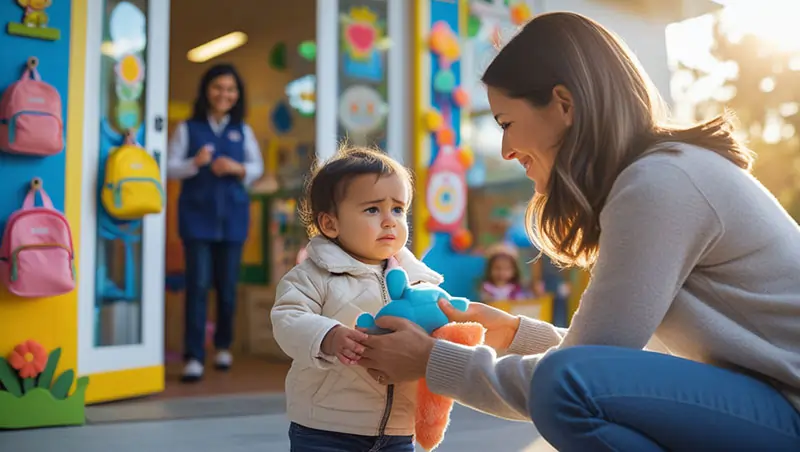Making a Smooth Transition to Daycare: Parent Tips
Beginning daycare is a major milestone for any family. It’s a mix of excitement, fears, and plenty of questions. Parents might be overwhelmed by the logistics or emotional pull of shipping their kid to school for the first time. But with the right strategy, you can make this transition smoother and sweeter for all parties involved. A seamless transition establishes your child for successful experiences, enabling them to feel comfortable and secure. This article provides essential advice on how to prepare your child, communicate with the caregivers, create routines, and care for your little one through this new experience.
Learning the Significance of a Gentle Transition
The psychological effect of early daycare on children
Acclimating your child to daycare can influence the way they form emotional attachments down the line. If children begin daycare with a soothing process, they are more likely to feel comfortable and trust teachers. Early positive experiences can enhance social abilities and emotional strength. If their transition is traumatic, however, it can result in long-term reluctance or fearfulness of new individuals and settings. Learn essential tips for a smooth transition to daycare in Grapevine, TX. Ensure your child feels comfortable and excited about their new environment.
Parental anxiety and emotions
Most parents are concerned about separation anxiety, judgment, or guilt regarding routines altering. It is to be expected that you will feel a little apprehensive when confronted with uncertainty. Having your own feelings in check keeps you composed and in the right place. Keep in mind that your child is looking to you for reassurance, so keeping your stress at bay can help.
Expert advice on successful transition techniques
Experts advise gradual exposure and open communication. It is advised to initiate with brief visits in advance and discuss daycare in a positive sense. Routine and consistency are stressed upon by the experts, familiarizing the new place with comforting and inviting routines. This makes children feel secure, easing their emotional adjustment.
Preparing Your Child for Daycare
Creating a Familiar Routine Prior to Enrolling
Start integrating daycare habits at home prior to your child’s first day. For instance, practice brief separations and maintain the same meal or nap times. This allows your child to adapt gradually and makes the new setting less overwhelming. Consistency in daily routines also promotes feelings of control and predictability.
Speaking positively about daycare
Use encouraging words when discussing daycare. Say things like, “You’ll play with friends” or “It’s a fun place.” These phrases shift focus from worries to excitement. If your child is scared, acknowledge their feelings. Say, “It’s okay to feel nervous,” and then remind them of the fun activities ahead.
Visiting the daycare facility ahead of time
Schedule a tour before your child begins. Allow them to get familiar with the building, become acquainted with staff, and observe where they will sleep. These tours eliminate unfamiliarity and increase confidence. Observe the way staff treats children and determine whether or not the atmosphere is safe and sanitary. Familiarity promotes comfort, making the transition for your child smoother.
Related reading: The Importance of Preschool in Child Development – What to Expect?
Effective Communication with Caregivers and Staff
Establishing a Partnership with Daycare Providers
Initiate open communication from the beginning. Discuss your hopes and concerns with employees. Inquire about daily habits, disciplinary policies, and security measures. Good collaboration will address your child’s needs, establishing mutual trust.
Sharing in-depth information about your child
Provide the caregivers with information such as allergies, sleep patterns, favorite toys, and routines. The more they understand about your child, the better equipped they are to assist their transition. Sharing information regarding your child’s personality and comfort objects assists staff in establishing a familiar and nurturing environment.
Remaining engaged during the transition
Go to orientation sessions and meet-and-greet events. Ask for frequent reports on your child’s progress, behavior, and social development. Your presence indicates to your child that you care, and it keeps you connected through this big transition.
Creating a goodbye ritual
Create a special good-bye ritual each morning — a wave, a special phrase, or a hug. Routine makes this predictable, which is reassuring to your child. It also reinforces the fact that separation is temporary and normal.
Carrying comfort objects from home
Let your child carry a beloved blanket, toy, or clothing with familiar smells. These are comforting and something they know. Ensure they are safe and washable so your child always has a bit of home with them.
Having consistency between home and daycare
Share a child’s daily routines with caregivers, such as nap times and snack schedules. When your child notices similarities between home and daycare, they transition more smoothly. Apply the same rules and language to ensure consistency remains strong, even on weekends.
Related reading: Things to Consider When Choosing a Kids Day-Care Center
Supporting Your Child During the Transition Period
Recognizing and responding to signs of distress
Search for behaviors such as clinginess, tearfulness, or withdrawal. These are indication that your child might be overwhelmed. Offer reassurance, soothing words, or a hug. Remaining calm calms them down too.
Gradual integration approach
Begin with shorter days and then progressively add time as your child grows accustomed. Or, start with only a few hours at first, and lengthen their stay at daycare. This phased approach allows your child time to adjust at their own leisurely pace.
Leaving room for adjustment
Realize that each child is unique. Don’t hurry the process. Be patient, persistent, and adaptable, making changes to your strategy based on your child’s response. With time and perseverance, they will become accustomed.
Support During the Transition to Sustain Success
Watching for signs of adjustment over a period of time
Monitor mood shifts, social behavior, and appetite. Discuss these with daycare staff, who can help intervene early. Open communication provides a cooperative team acting in your child’s best interest.
Reinforcing positive experiences at home
Mark milestones such as new friendship or new experiences with activities. Praise and support build confidence. Continue a loving routine at home, offering stability and reassurance after every day.
Adjusting strategies as needed
If difficulties persist, consider changing routines or using additional comfort items. Don’t hesitate to seek guidance from child development experts or counselors. Flexibility and attentiveness help your child grow stronger through this transition.
Conclusion
Adjusting to daycare is a big step that may initially seem intimidating. But with patience, open communication, and routines, you can ensure that your child feels secure and content in their new setting. Concentrate on establishing regular rituals, information sharing, and emotional support. Trust yourself and remember: every step you take today provides a basis for your child’s confidence tomorrow. Welcome this new adventure and celebrate the growth that comes with it.



